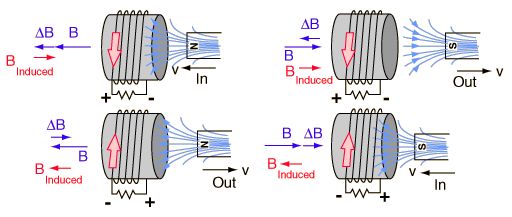Lenz's Law
When an induced current is generated by a change in magnetic flux, as stated by Farady's Law, the induced current will flow creating its own magnetic field that opposes the magnetic field that created it.
The Main Idea
Lenz's Law makes sure that Faraday's Law follows the conservation of energy as stated by Newton's Third Law. According to Faraday's Law, any change a the magnetic field will cause an induced current (emf). Lenz's Law accounts for the direction of the induced current. The change can be caused by the strength of the magnetic field, the direction of the magnetic field, the position of a circuit, the shape of a circuit, or the orientation of a circuit. The induced magnetic field inside a loop of wires is created to keep the magnetic flux in the loop constant.
A Mathematical Model
Lenz's Law is mathematically modeled as part of Faraday's Law. The negative sign in the equation represents the opposing induced field. [math]\displaystyle{ \epsilon = -{\frac{d\phi}{dt}} }[/math] where [math]\displaystyle{ \epsilon }[/math] is the emf of the system and [math]\displaystyle{ d\phi }[/math] is the change in the magnetic field.
Examples
Use the right hand rule to find the non-coulombic electric field in the given situations.

Solution
To use the right hand rule: place your thumb in the direction of the [math]\displaystyle{ -dB }[/math], then curl your fingers. The direction in which your fingers curl is the direction of the non-coulombic electric field. The non-coulombic field is represented by the pink arrows.
Connectedness
An interesting application for Lenz's Law is to cause rotation to create energy. In an industry setting, Lenz's Law can be applied to electric generators or electric motors. When a current is induced in a generator, the direction of the induced current will flow in opposition of the magnetic field that created it, causing rotation of the generator. And so, the generator needs more mechanical energy.
History
Henrich Friefrich Emil Lenz (1804-1865), a Russian physicist of German origin was born in Dorpat, nowadays Tartu, Estonia. Henrich studied chemistry and physics at the University of Dorpat in 1820 after his secondary education. From 1823 to 1826, he traveled with the navigator, Otto von Kotzebue on his third expedition around the world. During this journey he studied climate conditions, and properties of seawater. After his travels, he worked at the University of St. Petersburg, Russia, where he later became the Dean of Mathematics and Physics from 1840 to 1863. In the year of 1831, he started studying electromagnetism, and soon after in 1835, what is known today as Lenz's Law was created. Lenz died on February 10, 1865, just two days before his 61st birthday, after suffering a stroke, while in Rome.
See also
Since Lenz's Law and Farady's Law go hand in hand, Faraday's Law would be great supplemental information to read about. Newton's Third Law would also be a topic to read on for further understanding why Lenz's Law exists.
Further reading
Faraday's Law [1] Conservation Laws [2]
References
https://nationalmaglab.org/education/magnet-academy/history-of-electricity-magnetism/pioneers/heinrich-friedrich-emil-lenz http://hyperphysics.phy-astr.gsu.edu/hbase/conser.html http://regentsprep.org/regents/physics/phys08/clenslaw/ http://hyperphysics.phy-astr.gsu.edu/hbase/electric/farlaw.html http://farside.ph.utexas.edu/teaching/302l/lectures/node85.html http://www.electrical4u.com/lenz-law-of-electromagnetic-induction/